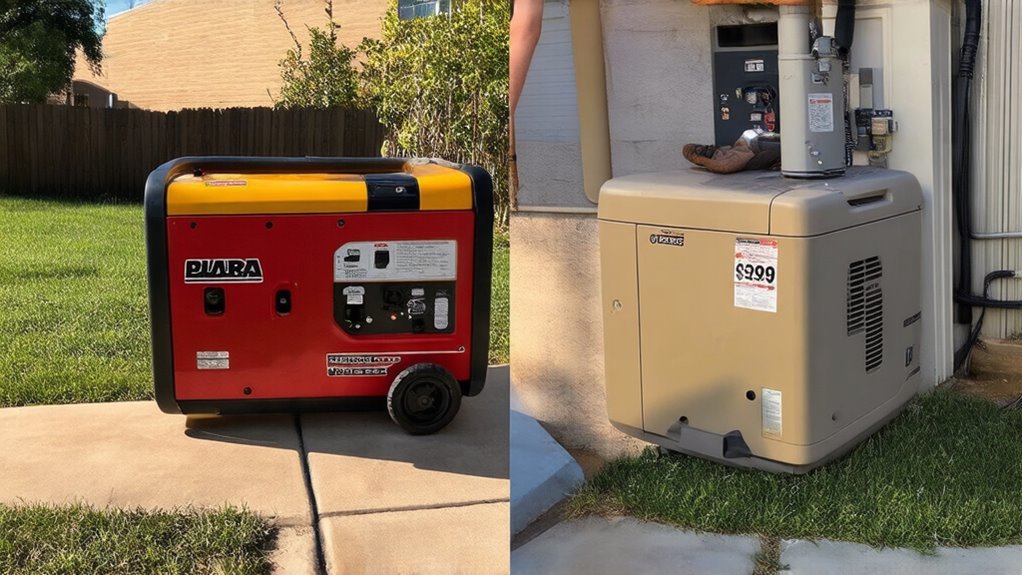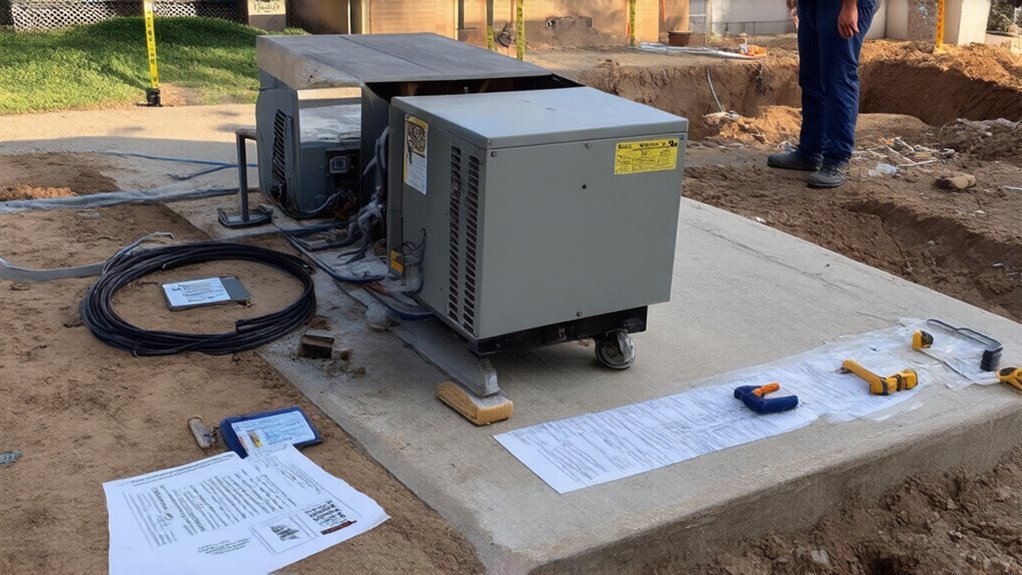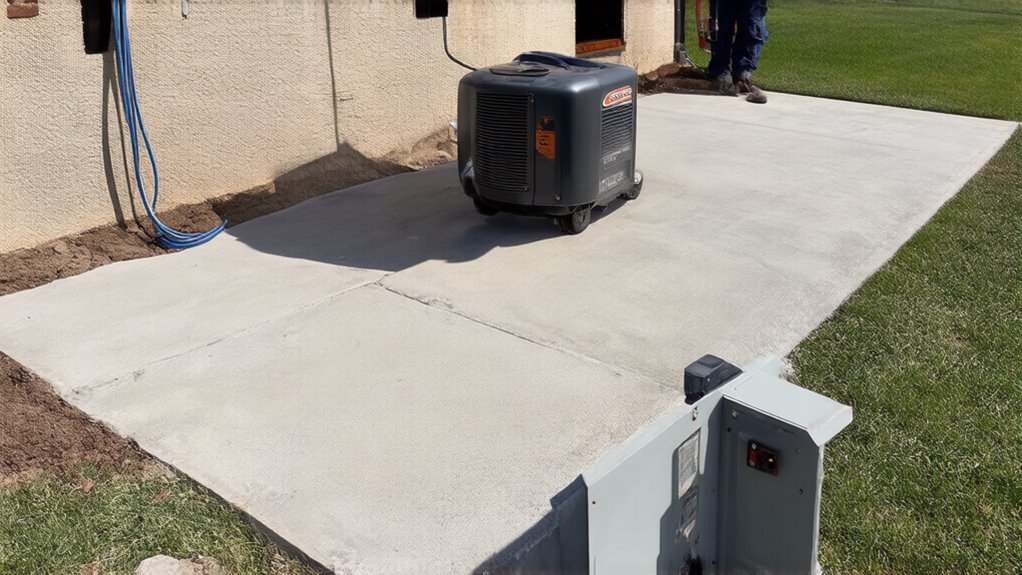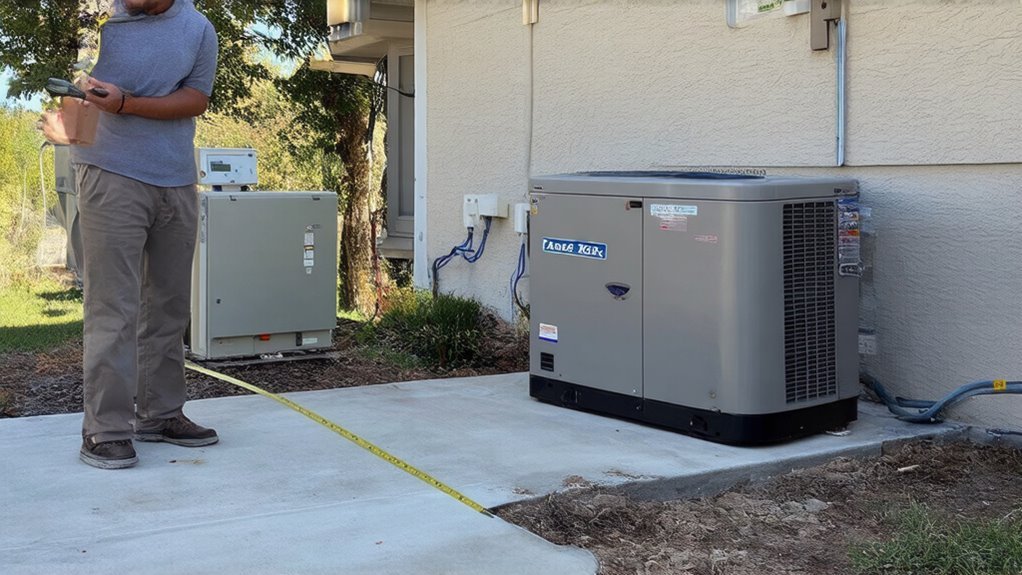Did you know that nearly 70% of homeowners considerably underestimate the total cost of generator ownership? I’ve seen countless people budget for just the unit itself, only to be shocked when installation doubles their expenses. After weathering three major power outages with my own standby generator, I’ve learned that understanding the full cost picture isn’t just about smart budgeting—it’s about ensuring you’ll actually have power when you need it most.
Portable vs. Standby: Comparing Initial Purchase Costs

When it comes to generator purchases, the price gap between portable and standby models is pretty substantial.
I’ve found that portable generators typically run a few hundred dollars, making them an attractive option for many homeowners. The portable generator advantages include not just the lower upfront cost, but also the flexibility to move them where needed.
Standby generator reliability, however, comes at a premium. These permanent installations can exceed $20,000 when you factor in transfer switches and fuel storage systems. Regular maintenance is vital for both types of generators, which can influence their overall cost.
Reliability isn’t cheap—standby generators represent a significant investment that can stretch budgets well beyond the $20K mark.
I think for most homes, the 3,000 to 7,500 watt range is probably sufficient.
Hidden Expenses: Installation Requirements and Permits

The initial price tag for generators only tells part of the story. When I purchased my standby system last year, I was surprised by the installation nuances that quickly added up. You’ll need a concrete pad, which requires excavation and professional pouring – not exactly DIY territory. Electrical wiring and gas hookup demand licensed professionals, and permit challenges vary dramatically between municipalities. I think I spent almost as much on installation as on the generator itself! Perhaps the most frustrating part was waiting for permit approvals, which took weeks in my area. Additionally, engaging in the installation process without professional expertise could lead to costly mistakes.
Concrete Pads and Transfer Switches: Setting Up Your System

Setting up your generator requires two critical components that I hadn’t fully appreciated until I started my own installation: a properly constructed concrete pad and a reliable transfer switch.
The concrete foundation isn’t just a platform—it’s essential for stability and longevity of your investment.
When planning your generator setup, consider these necessities:
- Professional excavation for proper pad placement
- Concrete thickness appropriate for your generator size
- Transfer switch setup by qualified electricians
- Permit acquisition (which varies by location)
- Proper positioning for maintenance access
I think the transfer switch is perhaps the most overlooked part, yet it’s what safely connects your generator to your home. A transfer switch ensures that there’s no backfeeding to the grid, which could be dangerous for utility workers and your system.
Without it, you’re looking at potentially dangerous workarounds.
Fuel Options and Their Long-Term Economic Impact

Choosing the right fuel for your generator involves more than just grabbing whatever’s available at the moment—it’s a decision that will impact your wallet for years to come.
I’ve seen homeowners overlook this vital aspect, focusing only on upfront costs.
Natural gas generators typically offer better fuel efficiency without the hassle of storage tanks, which might translate to long-term savings despite market fluctuations.
Natural gas generators deliver superior efficiency and eliminate storage headaches, potentially saving you money over time despite price volatility.
Propane and diesel, while requiring storage solutions, can be smart alternatives depending on your situation.
I think the most economical choice really depends on your local utility rates and, perhaps, how frequently you expect outages in your area. Additionally, propane’s long-term storage advantages can provide peace of mind as it does not degrade like gasoline.
Sizing Your Generator: Finding the Right Capacity for Your Home

Most homeowners I’ve worked with get overwhelmed when trying to determine the right generator size for their needs.
I’ve found that understanding your household consumption is the first step to finding the appropriate generator wattage.
When calculating your power needs, consider these essentials:
- Start with critical appliances (refrigerator, heating systems, security)
- Account for starting wattage, which can be 2-3 times higher than running wattage
- Most homes function well with 3,000-7,500 watts
- Add a 20% buffer for unexpected needs
- Consider future additions to your household and ensure that you are aware of common appliance power consumptions to avoid any surprises.
Cost vs. Protection: Calculating Your Return on Investment
When determining if a generator is worth the investment, I’ve found that many homeowners focus solely on the upfront costs without considering the long-term protection value.
A proper cost benefit analysis should include what you’d lose during extended outages. Think about it – spoiled food, hotel stays during extreme weather, or even potential water damage from frozen pipes. The outage impact adds up quickly!
I’ve seen folks save thousands by having backup power during critical moments. Perhaps the best return isn’t measured in dollars but in peace of mind. After all, protecting your family and home during emergencies? I’d say that’s practically priceless. Additionally, investing in a generator with a 5-5-5 Complete Coverage Plan can significantly reduce unexpected repair costs during power outages.
Maintenance Expenses: What to Budget for Year After Year
Although many homeowners focus on the initial purchase price of generators, I’ve learned that maintenance costs are just as important to evaluate in your long-term budget.
Regular upkeep guarantees your system works when you need it most.
Your yearly maintenance expenses typically include:
- Oil changes and filter replacements ($50-200 depending on size)
- Annual professional inspection ($150-300)
- Replacement parts as they wear (varies widely)
- Fuel stabilizer treatments ($20-40)
- Battery replacement every 2-3 years ($75-200)
Following manufacturer maintenance schedules prevents major repair costs down the road. Additionally, investing in essential tools for maintenance ensures that you can perform upkeep efficiently and effectively.
I think most homeowners underestimate these recurring expenses, which can add up to $300-500 annually for typical residential systems.
Professional Assistance: When to Call the Experts for Your Generator Needs
Despite the DIY approach many homeowners take with simpler aspects of generator ownership, certain situations absolutely require professional intervention.
When your generator misfires repeatedly or won’t start at all, it’s time to call in experts rather than risking further damage.
I’ve learned through experience that proper generator troubleshooting often requires specialized diagnostic equipment I simply don’t have at home.
Issues with electrical connections(https://example.com/electrical-connections), fuel systems, or transfer switches are particularly dangerous for amateurs to tackle.
Perhaps the most important time to seek help is during installation.
While it might seem expensive upfront, professional setup prevents costly—even life-threatening—mistakes down the road.
Frequently Asked Questions
How Long Do Generators Typically Last Before Needing Replacement?
Picture your trusty generator humming through storms—I’d say most generators last 10-20 years depending on maintenance. Watch for unusual noises, decreased power output, or frequent repairs as key replacement signs.
Can I Install a Generator in an Apartment or Condo?
I wouldn’t recommend it. Apartment regulations typically prohibit generator installation due to generator safety concerns, noise, and ventilation requirements. Check with your building management about allowed emergency power options instead.
Will My Home Insurance Rates Change After Installing a Generator?
I can’t say for sure if your insurance premium will decrease or increase. Check with your insurance policy provider—installing a generator might trigger a premium adjustment in either direction.
Are There Tax Incentives for Installing Backup Power Systems?
I’m not aware of specific tax credits for backup generators from the provided information. You might explore energy efficiency incentives through your local government or federal programs for certain power systems.
How Quickly Will a Generator Activate During a Power Outage?
I can tell you that standby generators typically offer rapid power response, activating within seconds of an outage. Portable generators require manual activation, which extends their activation speed considerably.